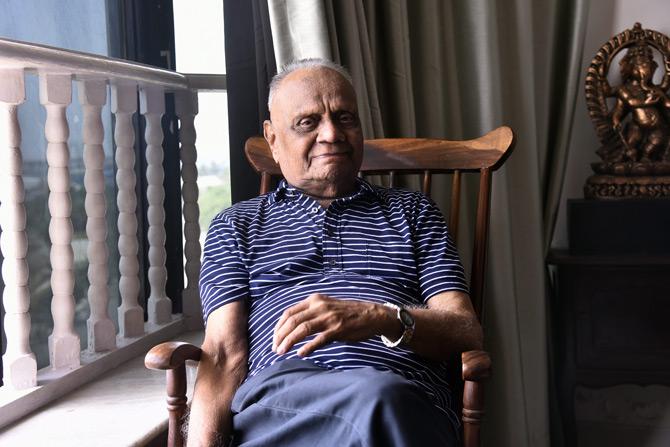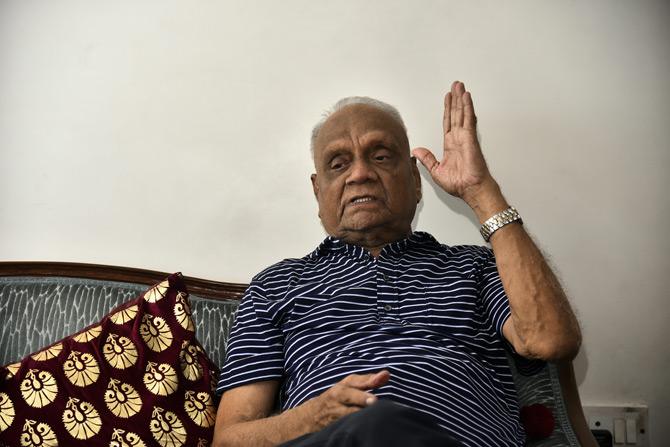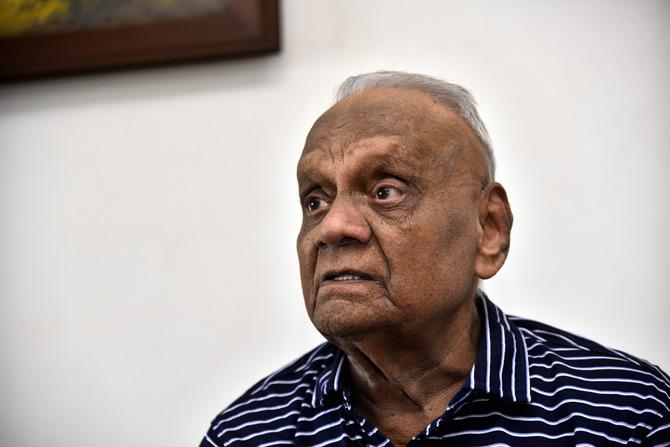DM Sukthankar is recognised as an expert on issues related to urban development and management, municipal administration and housing

Speaking about Metro, Sukthankar agreed that Metros should have come much earlier. All Pictures/Pradeep Dhivar
A 1910 Raja Ravi Varma painting of the 'Shiva family' hangs on the wall of the living room facing the Worli connector of the Bandra Worli Sea Link. Amid the soft tinkling of wind chimes tuning their own notes as the sea breeze hits them, soft music of old Marathi songs plays on a Caravan portable radio. I was waiting to interview Maharashtra's retired bureaucrat D.M. Sukthankar at his bright and compact Worli apartment, peppered with antique furniture and memorabilia.
ADVERTISEMENT
Sukthankar has seen it all. He has seen Mumbai grow in his nearly 35 year-long illustrious career in the Indian Administrative Service (IAS) as, inter alia, the Metropolitan Commissioner and chief of what was then the Bombay Metropolitan Region Development Authority (BMRDA), now the MMRDA, Mumbai city's Municipal Commissioner, and as Maharashtra's Chief Secretary.
Humble and down to earth, he animatedly says as he walks into the room wearing a navy blue T-shirt, "I may not be the right person to answer all your queries having seen your questions, but will be happy to share what I can." and further sums up his opinion on Mumbai's growth in one sentence - "Mumbai's solutions substantially lie elsewhere, not merely in the city."

D.M. Sukthankar at his Worli residence
An officer of the Maharashtra cadre of IAS from 1956, Sukthankar, besides being Mumbai's civic boss and the MMRDA Commissioner, has held several important portfolios in the Government of Maharashtra, including that of Secretary (Education), Secretary (Industries and Labour). He finally retired as the Chief Secretary to the Government of Maharashtra in August 1990. He was also the Secretary of the Ministry of Urban Development, Government of India, for two years (1986-88). He is recognised as an expert on issues related to urban development and management, municipal administration and housing.
As per official records, it was in 1977 that the BMRDA proposed land around Bandra-Kurla, Oshiwara, Kanjurmarg, Kalyan Complex, and New Bombay to be developed as district centres to decongest the then city of Bombay by relocating trading hubs and industries crowding the city. First identified in 1948 in the visionary plan for the future development of Bombay, the Bandra-Kurla Complex was one of the key focus areas for the relocation of activities to be shifted to decongest Bombay.
In March 1977, the Government of Maharashtra appointed BMRDA as the 'Special Planning Authority' for planning and developing the Bandra-Kurla Complex and thus began the journey to develop what has today become one of the prime real estates and commercial hubs of the 21st century in Mumbai.

Sukthankar said that the kind of infra work which is taking place will change the face of Mumbai in the next few years
"I was the Metropolitan Commissioner of BMRDA in 1980-81 and it was too early for the BKC to take discernible shape at that time. Those were the days when the land-filling for reclamation of land had just begun and we were the ones who had just started work on it. But if one looks beyond that, Mumbai's visionary planning had begun much earlier and I would give credit to J.R.D. Tata and S.G. Barve, former Indian Civil Services officer who later turned politician, for much of the groundwork." says Sukthankar.
"Remember, one of the important things for Bombay was to relocate the industries that were polluting the city and create new economic nerve centres. That is how the development began. The dispersal of economic activity to ease the pressure on land was the priority. Besides BKC, I think the opening up of landmass in New Bombay was a major development in easing pressures on Mumbai," he adds.
"I would give major credit for the development of BKC to people like my old colleagues Vidyadhar Pathak, S.R. Kakodkar and Dev Mehta. Mehta was later the Metropolitan Commissioner of BMRDA who actually took things rapidly ahead," says Sukthankar, remembering that it was Mehta who earmarked and allotted funds from BMRDA's resources to set up the i) Heritage Conservation and ii) Environment Improvement Societies as independent entities to work in their respective fields along with MMRDA, which was focusing on planned development of the Mumbai metropolitan region.
When asked about the transport scenario of Mumbai, the immense pressure on the city’s local trains, and the delay in the development of Metros, Sukthankar agrees that Metros should have come much earlier. "But remember again. The priority of Governments in those days was the development of villages and rural areas. In cities, the focus was on the development of industries and manufacturing. Funds for development were not easily available, and we actually had to go around asking for money for the smallest of projects. After the tram network shut in 1964, there were trolleybuses running for quite some time to compensate for the loss. Though plans for Metros, which are highly capital intensive, were being discussed, the problem was of finance."
"Today, finance is not a problem and what one needs is a viable plan. The improvement of technology and the availability of finance has given unlimited opportunity to transform the present scenario. The focus today has shifted from manufacturing to services, particularly financial services. Undoubtedly, the kind of Metro and other infra work that is now happening in Mumbai will totally and overwhelmingly change the face of the city in the next few years. It will be a different, different city," he adds.

Sukthankar's contribution as Chief Secretary of Maharashtra was a major boost to the state's infrastructure
"Mumbai being a linear city has its own set of problems, unlike Delhi. But now things are finally shaping up. The Navi Mumbai axis is in place and with the Mumbai Trans Harbour (MTHL) link work about to proceed, the eastern axis and connectivity to Uran and the hinterlands will be a reality. The Government recently included Palghar to the north in the jurisdiction of MMRDA and on the eastern side the new airport is already under works. This will be a big boost and open up connectivity in all directions. The MTHL link, I think, should also have a rail link, which will help in a big way," he says.
"I was the Municipal Commissioner between 1981 and 1984 and there were a few key decisions that changed the city forever. It was during that tenure of mine, that, for the first time, the concretisation of roads was begun in Mumbai. We started with arterial roads like P D'Mello Road and main traffic junctions. There was a decision to open up more fire stations as the city was growing. Another important move was the first water supply tunnel between Mahalaxmi and Malabar Hill, and this was for the first time that a tunnel boring machine that is so common today for Underground Metro and other projects was used anywhere in India," Sukthankar recalls proudly, adding that there was another important decision as civic chief which was debatable. "The removal of slums and encroachments from expressways and major roads of Mumbai led to prolonged litigation."
Sukthankar's significant contribution as Maharashtra's Chief Secretary in the 1990s was a major boost to the State's infrastructure. He gave the Konkan Railway connectivity the much-needed push by resolving conflicting issues during the line's planning and registration of its Undertaking as a company.
Looking back in nostalgia, Sukthankar says, "Today what Mumbai needs to look forward to is the creation of more open spaces, work on the augmentation of water supply and drainage systems, and focus on greening and environmental improvement of the city."
Catch up on all the latest Crime, National, International and Hatke news here. Also download the new mid-day Android and iOS apps to get latest updates
 Subscribe today by clicking the link and stay updated with the latest news!" Click here!
Subscribe today by clicking the link and stay updated with the latest news!" Click here!






